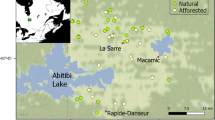Abstract
Carbon (C) sequestration within the context of the Kyoto protocol of the United Nations Framework Convention on Climate Change has great potential as an incentive for combating land degradation and desertification. Desertification continues to be a major threat to Iceland's natural resources. Revegetation in Iceland can both reduce C in the atmosphere by fixing C in vegetation and soil, and also reduce C emission by preventing further ecosystem damage, vegetation degradation and subsequent soil erosion. The sequestration potential in Iceland lies in the available land area and in the soil properties. Iceland has vast areas where vegetation can be enhanced or restored (10 000–45 000 km2), and the Andic nature of Icelandic soils tends to immobilize C. In the year 2001 the Soil Conservation Service worked on revegetation of roughly 13 000 ha or 130 km2, resulting in C sequestration of about 8000–14000 Mg C in 2001. Reclamation of degraded land through changed land use, and/or seeding and fertilizing can promote sustainable development and healthier ecosystems, increase biological diversity and soil fertility, in addition to mitigating climate change through C sequestration.
Similar content being viewed by others
References
Aradóttir Á.L., Svavarsdóttir K., Jónsson T.H. and Gudbergsson G. 2000. Carbon accumulation in vegetation and soils by reclamation of degraded areas. Icel. Agr. Sci. 13: 99–113.
Arnalds A. 1999. Incentives for soil conservation in Iceland. In: Sanders D., Huszar P.C., Sombatpanit S. and Enters T. (eds), Incentives in Soil Conservation. Science Publishers, Inc. on behalf of WASWC, IBSRAM, SWSCT and DLD, Bangkok, Enfield, New Hampshire, pp. 135–150.
Arnalds A. 2000. Evolution of rangeland conservation strategies. In: Arnalds O. and Archer S. (eds), Rangeland Desertification. Kluwer Academic Publishers, Dordrecht, The Netherlands, pp. 153–163.
Arnalds O., Aradóttir Á.L., Snorrason A., Gudbergsson G., Jónsson T.H. and ÁgÚstsdóttir A.M. 1999. Organic carbon sequestration by restoration of severely degraded areas in Iceland. Preliminary results. Fjölrit Rala 197: 19.
Arnalds O., Gudbergsson G. and Gudmundsson J. 2000. Carbon sequestration and reclamation of severely degraded soils in Iceland. Icel. Agr. Sci. 13: 87–97.
Arnalds O., Hallmark C.T. and Wilding L.P. 1995. Andisols from four different regions of Iceland. Soil Sci. Soc. Am. J. 59: 161–169.
Arnalds O. and Kimble J. 2001. Andisols of deserts in Iceland. Soil Sci. Soc. Am. J. 65: 1778–1786.
Arnalds O., Thórarinsdóttir E.F., MetÚsalemsson S., Jónsson Á., Grétarsson E. and Árnason A. 2001a. Soil erosion in Iceland. (English translation, originally published in Icelandic 1997). Soil Conservation Service, Agriculture Research Institute, Reykjavík, Iceland.
Arnalds O. 2004. Volcanic soils of Iceland. In: Arnalds O. and Stahr K. (eds), Volcanic Soil Resources. Occurrence, Development and Properties. Catena 56 (special issue): 3–20.
Arnalds Ó., Gísladottir F.Ó. and Sigurjónsson H. 2001b. Sandy deserts of Iceland: an overview. J. Arid Environ. 47(3): 359–371.
Arnalds Ó. and Grétarsson E. 2001. Soil map of Iceland. 2nd edition. Agricultural Research Institute (RALA), Reykjavík, Iceland.
Batjes N.H. 1999. Management options for reducing CO2-concentrations in the atmosphere by increasing carbon sequestration in the soil. Dutch National Research Programme on Global Air Pollution and Climate Change, Technical Paper 30. International Soil Reference and Information Centre, Wageningen, The Netherlands.
Bjarnason H. 1942. ÁbÚ og örtrö. Ársrit Skógræktarfélags Íslands 1942: 8–40 (In Icelandic).
Bruce J.P., Frome M., Haites E., Joanne H., Lal R. and Paustian K. 1999. Carbon sequestration in soils. J. Soil Water Conserv. 54: 382–389.
Einarsson M.Á. 1976. Climate of Iceland (In Icelandic).I unn, Reykjavík, Iceland.
Fridriksson S. and Sigurdsson F.H. 1983. The effect of air-temperature on grass growth (In Icelandic with English summary). J. Agr. Res. Icel. 15(1–2): 41–54.
Gudjónsson G. and Gíslason E. 1998. Vegetation Map of Iceland. 1: 500.000. General Overview. (1st edition). Icelandic Institute of Natural History, Reykjavik, Iceland.
Hoffert M.I., Caldeira K., Benford G., Criswell D.R., Green C., Herzog H. et al. 2002. Advanced technology paths to global climate stability: Energy for a greenhouse planet. Science 298: 981–987.
Kennett S.A. 2002. National policies for biosphere greenhouse gas management: Issues and opportunities. Environ. Manage. 30: 595–608.
MagnÚsson B., MagnÚsson S.H. and Sigurdsson B.D. 2001. Vegetation succession in areas colonized by the introduced Nootka lupin (Lupinus nootkatensis) in Iceland (In Icelandic with extended English summary). Fjölrit Rala 207: 100.
Marland G., McCarl B.A. and Schneider U. 2001. Soil carbon: Policy and economics. Clim. Change 51(1): 101–117.
Ministry for the Environment in Iceland 2002. The Policy of the Icelandic Government regarding mitigation approaches towards obligations of the FCCC and the Kyoto Protocol (In Icelandic). Retrieved 29.10.02 from http://umhverfisraduneyti.is/interpro/ umh/umh.nsf/pages/stefnumorkun.
Ministry of Agriculture 2001. Lokaskýrsla verkefnisstjórnar um átak í landgræ slu og skógrækt. (In Icelandic). Land-bÚna arrá uneyti (Ministry of Agriculture), Reykjavik, Iceland.
Óskarsson Ú. 2000. Carbon sequestration in vegetation and soil. Program report 1999. (In Icelandic with extended English summary). Verkefnisstjórn átaks í landgræ slu og skógrækt 1997–2000.
Post W.M. 1993. Organic carbon in soils and the global carbon cycle. In: Heimann M. and Pearman G. (eds), The Global Carbon Cycle. Springer Verlag, Berlin, Germany.
Runólfsson S. 1978. Soil conservation in Iceland. In: Holdgate M.W. and Woodman M.J. (eds), The Breakdown and Restoration of Ecosystems. Plenum Publishing Corporation, New York, pp. 231–240.
Runólfsson S. 1987. Land Reclamation in Iceland. Arctic Alpine Res. 19: 514–517.
UNEP 1992. Convention on Biological Diversity, Convention Text. http://www.biodiv.org/convention/articles.asp.
United Nations 1994. United Nations Convention to Combat Desertification in Countries Experiencing Serious Drought and/or Desertification, Particularly in Africa. United Nations, New York.
Author information
Authors and Affiliations
Rights and permissions
About this article
Cite this article
Ágústsdóttir, A.M. Revegetation of eroded land and possibilities of carbon sequestration in Iceland. Nutrient Cycling in Agroecosystems 70, 241–247 (2004). https://doi.org/10.1023/B:FRES.0000048476.18780.f2
Published:
Issue Date:
DOI: https://doi.org/10.1023/B:FRES.0000048476.18780.f2




